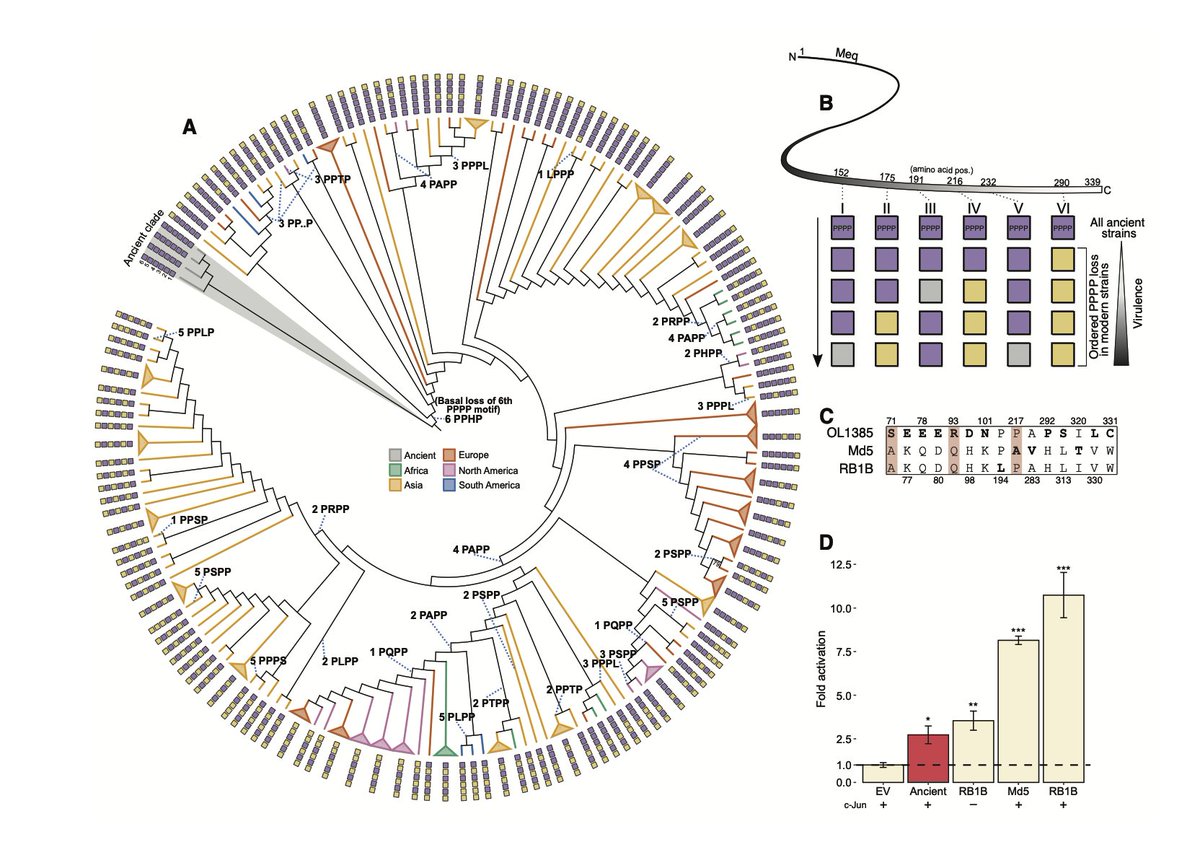How do #pathogens become more virulent? Read on for a tale of #ancient bones, #ancientDNA, and a very modern danger in the chicken industry… 🧵1/14 

The culprit is Marek’s Disease Virus – a cancer-causing herpesvirus of chickens that causes mortality in >90% of unvaccinated birds. Highly transmissible and persistent in the environment, the #poultry industry spends 💵$bns controlling this disease. 2/14
It hasn’t always been like this, though. In fact, when József Marek first described the disease in the 1900s, he described a disease which caused nerve inflammation, transient paralysis and little more. Importantly, no cancer and very little mortality. 3/14 

This is a remarkable transition from mild disease to hypervirulence in just 100 years – why did it happen? 4/14
A perfect storm of a burgeoning poultry industry combined with leaky #vaccines (prevent disease symptoms but not transmission) are likely to have given the virus freedom to explore levels of virulence that, under natural conditions, would have been an evolutionary dead-end. 5/14
But MDV also presents an opportunity: a semi-natural #experiment to study the mechanism of pathogen virulence changes. Our new paper, out now in @ScienceMagazine, uses ancient DNA to understand the genetic basis of virulence changes in MDV. 6/14tinyurl.com/yjsapd96
We teamed up with archeologists, gathered 1000 ancient chicken bones from all over Europe and the Middle East, and sifted through their highly fragmented DNA for evidence of a viral relic: gentler #MDV from ancient times. 7/14 

We found it! 15 samples with enough evidence to say that these ancient chickens had an MDV infection when they died. The virus was clearly everywhere in Europe - France in the C10th, C16th Russia, C16th Spain, C19th Iran… 8/14 

We found 49 MDV genes that evolved under positive selection between the ancient and modern samples – the gap in which MDV became highly virulent. Several of these were known #virulence factors, but one caught our eye… 9/14 

Meq – the viral gene that drives tumor formation – was heavily selected in the branch leading to modern MDV, with changes in a proline-rich region of the protein that are highly suggestive of a change in function. 10/14
To confirm our suspicions, we resurrected the ancient form of the gene and tested it alongside Meq from modern, virulent MDV in chicken cells. We measured the ability of the protein to transcriptionally activate (turn on) its target genes and orchestrate #tumor formation. 11/14
The difference was stark. Ancient Meq was nowhere near as effective as the modern Meq at activation, so was likely unable to drive tumor formation in a living chicken. Marek was right – no tumors in this old form of the disease – and at least partly down to Meq. 12/14 

More generally, we found that the genetic changes act like a ratchet – the mutations are almost always acquired in a specific order and once done, are never undone. 13/14
This work is just one of many arguments for using #archeological samples, which are relevant not only to our past, but our future too. Never has the need to understand how pathogens evolve been greater: the past contextualizes the present and predicts the future. 14/14
Thanks for reading. This was a huge team effort in which I was privileged to play a part. Thanks to @dim_antoni99722 @ArchaeOphelie @laduplessis @SophyCharlton @AHaruda @pgflammer @mephitis @AlisonFoster42 @MashkourM @EvolveDotZoo @Greger_Larson @LrFrantz and many more.
Work was done at @OxfordBiology and @school_of_arch at @UniofOxford and @LMU_Muenchen, kindly funded by @ERC_Research, @oxmartinschool @wellcometrust and others. Paper: /endtinyurl.com/yjsapd96
• • •
Missing some Tweet in this thread? You can try to
force a refresh

 Read on Twitter
Read on Twitter



